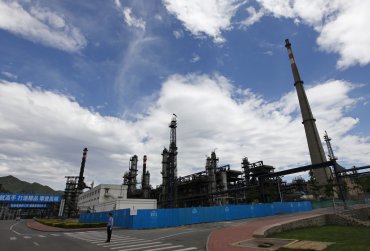Chinas base oil consumption will grow marginally but steadily in the next five years, according to a speaker from ICIS at the organizations World Base Oils & Lubricants Conference in London last week. In 2021, API Group II and III grades will have elbowed out Group I and off-spec oils more than ever as total demand inches closer to 9 million metric tons.
Automotive lube demand in China continues to climb, with last years production and sales of automobiles reaching 29 million and 28 million units, respectively, Senior Markets Editor Jasmine Khoo said during a pre-conference seminar on Feb. 21. Domestic base oil demand is following suit, forecast to reach 8.8 million tons by 2021, after an 11 percent climb from 2016 levels.

Photo courtesy of Sinopec
Sinopec stopped making Group I base stocks at its facility in Yanshan in 2015 due to lack of feedstock.
Requirements and sources are likely to change as much in the next five years as they did in the past five, the Asia base oils analyst continued. Capacities were mostly on an upward trend in that time frame, with a lot of Group II units coming on stream.
In 2016, Group II capacity finally overtook Group I capacity, reaching 49 percent of all [paraffinic] output compared to Group Is 48 percent, she said, noting that the remaining 3 percent is occupied by Group III, which saw more growth after Sinopec Maomings plant began streaming that year. Meanwhile, No new Group I plants opened in 2016, she pointed out.
Group II base oils consumption was more than 3.3 million tons in 2016, up by 24 percent year on year, she said. Group I and off-spec base oils demand both declined year on year and were gradually substituted with Group II and Group III … and Group III base oils and naphthenic base oils apparent consumption both rose year on year. Khoo defined off-spec as low-quality, non-API-approved products often made in so-called tea-pot refineries which are rapidly being shut.
Group II was the most-required grade in China in 2016, representing around 42 percent of the countrys demand, followed by Group I, which is stubbornly maintaining 23 percent. Naphthenic cuts are used as much as off-spec products, with both categories holding 13 percent, followed by Group III at 9 percent.
In terms of capacity, state-owned suppliers battled with a collection of independent refiners for the largest slice of the pie in 2016, with Sinopec narrowly elbowing ahead of PetroChina for a 32 percent share. Independent refiners capacities [have] increased due to the intensive expansions and start-ups of Group II base oils units, to a combined 27 percent share in 2016, she noted. CNOOC followed behind PetroChinas 30 percent with an 11 percent share after its Taizhou unit came online.
Two more indie refineries are set to commence this year, she noted, reminding attendees that Qingyuan Petrochemical is aiming to open a Group I/II plant with 800,000 tons per year capacity by the end of the second quarter and that Dalian Hengli Petrochemical expects to open a 540,000 t/y plant by the end of the year or in early 2019. The industry is still awaiting an update on Hainan Handi Sunshine Petrochemical Co.s long-discussed Group III plant in Hainan, she noted.
With new capacity, some segments of the market continue to be oversupplied. In terms of the nameplate capacity, low-viscosity Group II base oils are net long after several new plants started operation in the past five years and could fulfill the domestic need.
Yet imports still represent a large part of the market, climbing 10.5 percent year over year in 2016 and marginally again in 2017 to around 2.8 million tons, according to information that ICIS obtained from Chinas General Administration of Customs.
Virtually unchanged from the year before, South Korea was Chinas largest source of imports in 2017, representing almost 35 percent of the total volume of foreign base oils, or 979,000 tons. Singapore increased its volume of supply into China by 26 percent from 2015 to 2016, for a 28 percent share of all Chinas imports, and then lost a bit of that share to settle at 26 percent in 2017.
Some of Singapores 2016 volume may have been substituted with Middle East-based product last year, as China imported around 76,000 tons from Emirati suppliers. Chinas Group III imports spiked 35 percent from 2015 to 2016, and most of that increased volume came from the U.A.E. Khoo added that, as the One Belt One Road Initiative picks up steam, China is likely to be increasingly seen as a feasible recipient of more products from the Middle East.
In 2016, 56 percent of Chinas imports were Group II, and around 21 percent were Group III. Import volumes of Group I base oils represented 22 percent of all imports, which was a slight increase over the previous year due to local supply constricting that year, she said. Yet industrial lube demand receded in 2016 due to sluggish steel and power industries, further reducing demand for Group I.
Exports of base oils from China are nowhere near the peak reached in 2012, which was a mere 75,000 tons, approximately, but volumes did increase 151 percent in 2016 from the year before, to approximately 45,000 tons. However, most of those exports were actually re-exports, Khoo concluded.